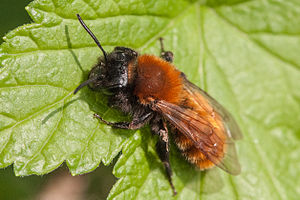Red-furry sand bee
| Red-furry sand bee | ||||||||||||
|---|---|---|---|---|---|---|---|---|---|---|---|---|

Red-furry sand bee ( Andrena fulva ) |
||||||||||||
| Systematics | ||||||||||||
|
||||||||||||
| Scientific name | ||||||||||||
| Andrena fulva | ||||||||||||
| ( OV Müller , 1766) |
The red-furry sand bee ( Andrena fulva ) is a European species of bee from the genus of sand bees ( Andrena ).
features
Like many species of bees, the animals show a significant sexual dimorphism.
male
The males reach a size of 9–12 mm. They have quite a lot of red-brown hair all over their body. The hair is generally lighter on the underside than on the top. Their mandibles are long and have a tooth at the base. The males look quite similar to other male sand bees, e.g. B. those of the common redheaded sand bee . However, these do not have a tooth at the base of the mandible.
female
The females are 12-14 mm tall. They are densely hairy fox-red on the upper side. The underside, head and legs are completely black haired. Due to their fur, they appear broad and resemble bumblebees. The females can hardly be mistaken for their distinctive habitus. Only old animals, whose fur has faded and worn out, can cause trouble.
Occurrence
The red-furry sand bee lives in Central Europe , in the east to the Balkan Peninsula , in the north to southern Scandinavia . They live in open forests and on dry grass , but also in parks and gardens. They fly from March to May and are widespread, but tend to be found in low population densities.
Way of life
The animals are not picky about a variety of different nectar plants. They are an important pollinator, especially for currant and gooseberry bushes . They make their nests in the ground, preferably in bare places. The nests are mostly isolated, occasionally in loose groups. The males emerge a little earlier than the females in March. After the mating season, the males usually pass as early as April, while the females continue the breeding business until around the end of May. In contrast to the honey bee , the red-furry sand bee does not form states, but each female has her own nest. It is therefore also counted among the hermit or solitary bees . The nest consists of a 20 to 30 centimeter deep, vertical tube from which several brood cells branch off. These are filled with nectar and pollen . One egg per cell is placed on top of the pollen-nectar mixture, the so-called food pulp, from which a larva hatches in a few days . The larvae grow up quickly and pupate in a few weeks. The adults hatch in spring after the winter rest. The nests are infested by the cuckoo bees Nomada signata and Nomada panzeri .
literature
- Heiko Bellmann : bees, wasps, ants. Hymenoptera of Central Europe . Franckh-Kosmos Verlags-GmbH & Co KG, Stuttgart 1995, ISBN 3-440-09690-4
Web links
- wildbienen.de Andrena fulve (German)
- Andrena fulva nature walk (German)
- BWARS Andrena fulva (Eng.)
- Andrena fulva in the Atlas Hymenoptera (French)